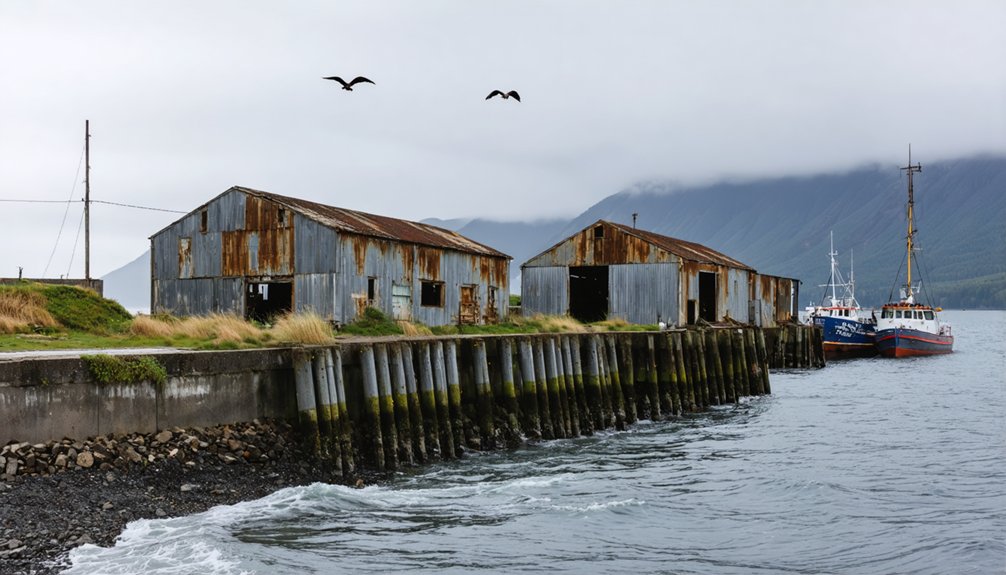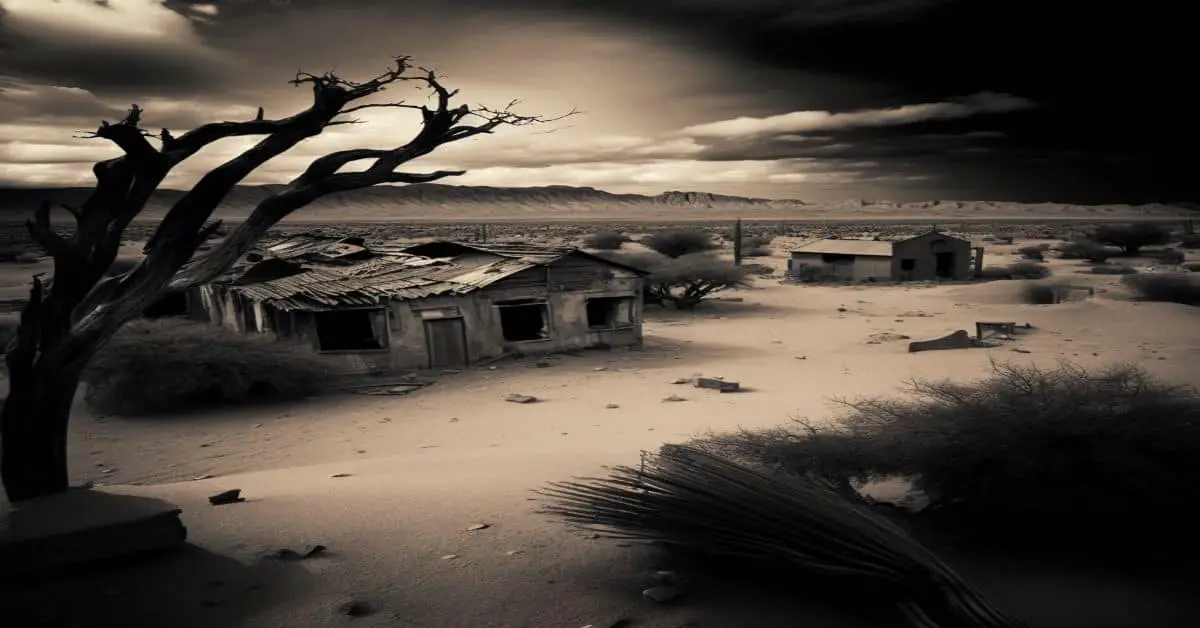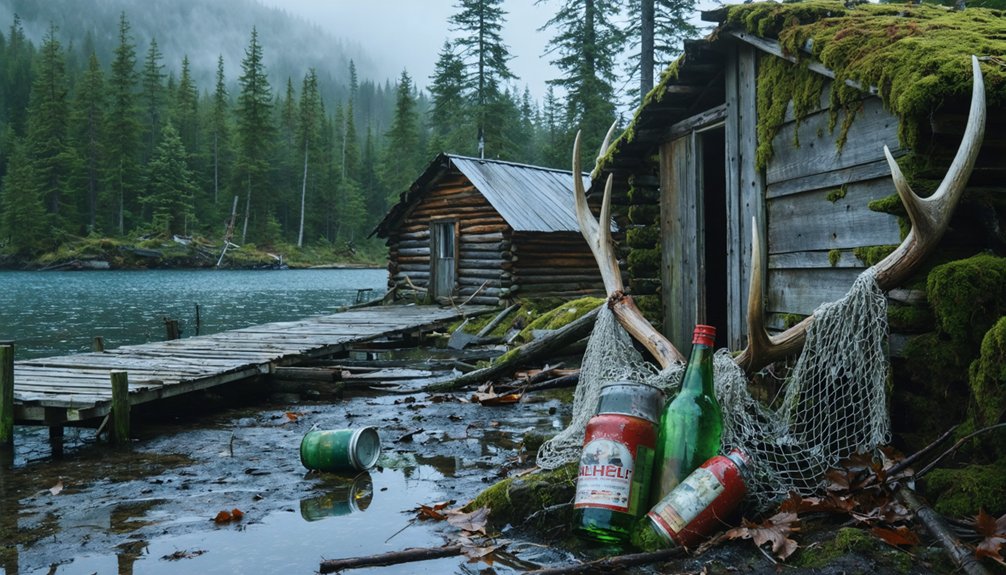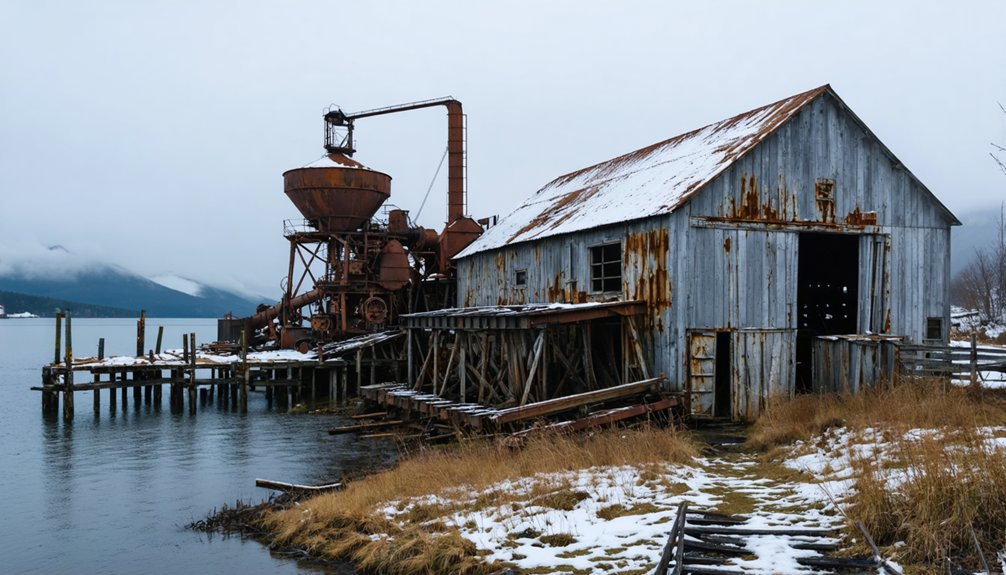You’ll find Three Saints Bay, Alaska’s first permanent Russian settlement, nestled in a sheltered harbor on Kodiak Island. Established in 1784, this colonial outpost faced harsh terrain, violent conflicts with local Alutiiq people, and devastating natural disasters. After major tsunamis in 1788 and 1792 severely damaged the settlement, residents relocated to Saint Paul Harbor. Today, the abandoned site holds National Historic Landmark status, with archaeological remains revealing centuries of cultural collision and resilience.
Key Takeaways
- Three Saints Bay, established in 1784 as Russia’s first permanent Alaskan settlement, became a ghost town after devastating natural disasters.
- A series of earthquakes and tsunamis in 1788 and 1792 forced settlers to abandon the site for Saint Paul Harbor.
- The settlement’s remains include archaeological evidence of Russian colonial structures and indigenous Alutiiq dwelling sites.
- The site gained National Historic Landmark status in 1978, though coastal erosion threatens its preservation.
- The abandoned settlement’s location featured steep hillsides and limited usable shoreline, contributing to its ultimate failure as a permanent colony.
The Birth of Russian Alaska’s First Settlement
Three pivotal events marked the birth of Russian Alaska’s first permanent settlement in August 1784.
First, merchant Grigory Shelikhov selected Three Saints Bay on Kodiak Island, drawn to its deep, sheltered harbor that could protect Russian ships.
Second, you’ll find he established this outpost not just as another seasonal fur-hunting station, but as Russia’s first permanent colonial foothold in North America.
Third, Shelikhov’s forces violently confronted the local Alutiiq people in what became known as the Awa’uq Massacre, forever altering the region’s cultural landscape.
Despite these colonial ambitions, the settlement faced immediate challenges.
You’d discover the site’s limitations: steep hillsides unsuitable for building, minimal shoreline for development, and insufficient timber and farmland.
These settlement challenges would ultimately force relocation to Pavlovskaya Gavan in 1792. The devastating earthquake and tsunami that year made the decision to abandon the site inevitable.
Today, only archaeological pits and rectangular depressions remain as evidence of this historic Russian settlement.
Life Among the Steep Hills and Rocky Shores
The harsh realities of life at Three Saints Bay quickly emerged as settlers confronted its challenging terrain.
You’ll find steep mountains rising straight from the shoreline, restricting movement and limiting usable land. While the deep 66-foot harbor offered safe anchorage, the lack of accessible timber and buildable sites posed constant challenges for the Russian colonists. The settlement faced complete destruction when a devastating tsunami struck in 1788.
Today, local residents continue subsistence harvesting traditions, gathering fish and hunting marine mammals in these waters. The Sugpiaq people’s subsistence strategies proved far more sustainable, as they’d mastered indigenous adaptations over thousands of years.
You can trace their sophisticated hunting of marine mammals, fishing practices, and seasonal foraging patterns that worked within the bay’s constraints.
Yet for the Russians, these same environmental challenges proved insurmountable – forcing them to abandon their settlement by the 1790s, leaving the rugged coastline to return to its traditional stewards.
Dark Days: The Awa’uq Massacre and Colonial Violence
During a fateful day in August 1784, Russian fur trader Grigory Shelikhov released devastating violence against Kodiak’s indigenous Alutiiq people at Refuge Rock (Awa’uq), marking a dark turning point in Alaska’s colonial history.
You’ll find evidence of this colonial trauma in both Russian records and Alutiiq oral traditions. After firing guns and cannons at the defenseless people, Shelikhov’s forces killed hundreds – possibly thousands – while taking no casualties themselves. The Alutiiq term “Awa’uq” meaning “to become numb” reflects the profound devastation of this event.
They captured over 1,000 survivors, holding 400 as hostages. A young interpreter named Qaspeq, raised by Russians after being taken as a child, had betrayed his people by revealing Awa’uq’s location. Following the massacre, the Russian invaders forced the captured Alutiiq men and boys into sea otter hunting slavery.
Despite this blow to indigenous resilience, the site stands today as a monument to Alutiiq survival, remembered as Alaska’s “Wounded Knee.”
Trading Post Economics and Daily Operations
You’ll find Three Saints Bay‘s trading operations revolved entirely around sea otter pelts, with forced Sugpiaq/Alutiiq labor providing the backbone of fur procurement and processing.
The site’s natural harbor facilitated Pacific trade routes, connecting Russian merchants to lucrative Chinese markets while importing essential supplies like tools and textiles.
Working conditions were harsh, as the Russian-American Company maintained strict control over Native hunters and workers who sustained the post’s daily operations through hunting, food preparation, and support services.
The post’s operations were administered from a central Russian krepost fort until administrative functions moved to St. Paul Harbor in 1792.
Grigory Shelikhov established this first permanent Russian settlement in Alaska, marking the beginning of Russia’s formal presence in North America.
Fur Trading Supply Chain
While serving as Russia’s primary North American outpost in the 1780s, Three Saints Bay operated as a critical hub in the transoceanic fur trade supply chain, connecting Alaskan hunting grounds to lucrative Asian markets.
You’ll find this remote settlement mastered complex logistics despite significant challenges:
- Sea otter pelts were collected from indigenous hunters and processed on-site.
- Deep natural harbor enabled safe anchoring for Russian trading vessels.
- Limited local resources required constant supply shipments from Russia.
- Furs moved through a sophisticated network stretching from Alaska to China.
- Basic infrastructure supported temporary storage before overseas transport.
The settlement’s position in the supply chain eventually proved unsustainable due to limited building space, scarce timber, and difficult terrain.
These factors, combined with natural disasters, led to the relocation of operations to St. Paul’s Harbor.
Labor and Work Conditions
Life at Three Saints Bay revolved around a complex labor hierarchy that reflected the stark social divisions of Russian colonial expansion. You’d find Russian merchants and officials at the top, directing operations while indigenous Unangax̂ and Sugpiaq peoples faced labor exploitation through both coerced and voluntary service. The settlement operated under Imperial Naval officers who took control of management positions after Baranov’s time.
The harsh reality was that native workers endured dangerous conditions, devastating diseases, and violent treatment while performing essential tasks like hunting, fishing, and construction. Like modern Alaska Native Corporations, the settlement operated to provide economic opportunities for indigenous communities.
Despite systematic oppression, indigenous resilience emerged through significant contributions to the settlement’s survival. Their expertise in marine resource gathering proved essential, especially during food shortages.
The trading post’s daily operations followed seasonal rhythms, with intensive hunting in summer months and maintenance work during winter. All labor was localized due to the settlement’s isolation, requiring everyone to adapt to challenges like limited resources and recurring natural disasters.
Commerce With Native Peoples
The daily operations of Three Saints Bay trading post revealed a complex web of economic relationships between Russian merchants and native peoples.
The economic impact extended far beyond simple trading, fundamentally reshaping the region’s commercial dynamics and cultural landscape.
You’ll find these key aspects of commerce at Three Saints Bay:
- Russian traders established a monopoly over the lucrative fur trade, controlling the flow of goods in and out of the region.
- Alutiiq people participated in hunting and food preparation, though often through coerced labor.
- The trading post served as a storage facility and distribution center for goods.
- Cultural exchange occurred despite the unequal power dynamics between Russians and natives.
- The Russian Orthodox Church’s presence added another layer to commercial relationships, influencing how trade was conducted.
Natural Forces Reshape History
You’ll find that Three Saints Bay‘s fate was sealed by a devastating earthquake in 1792, which triggered a massive tsunami that obliterated the Russian settlement’s structures and infrastructure.
The combination of seismic activity and tidal destruction forced the remaining 50-70 inhabitants to abandon their colonial outpost and relocate to present-day Kodiak.
Nature had reclaimed the site so thoroughly that today, only depressions and archaeological remnants mark where this first permanent Russian settlement in Alaska once stood.
Destructive Earthquakes Strike Settlement
During the late 18th century, devastating earthquakes reshaped Three Saints Bay‘s destiny, with the most catastrophic strike occurring in 1788 along the Alaskan megathrust fault near Kodiak Island.
The earthquake impact forced Russian colonists to abandon their strategic outpost after severe ground subsidence and destruction made the site uninhabitable.
- Ground deformation and hillside destabilization undermined the settlement’s foundation
- Tsunami waves destroyed limited shore infrastructure and small buildings
- Land subsidence increased flooding risks, reducing usable settlement areas
- Archaeological remnants reveal foundation depressions from the destruction
- A subsequent 1792 earthquake, lasting 18 hours, sealed the settlement’s fate
You’ll find that Three Saints Bay’s settlement abandonment marked a turning point, as Russian authorities relocated their main colonial base to present-day Kodiak by 1791-1792, leaving the original site to fade into history.
Tsunami Forces Mass Exodus
On July 21, 1788, a powerful earthquake near Sitkinak Island released devastating tsunami waves that forever changed Three Saints Bay‘s destiny.
You’ll find evidence of waves reaching heights of 3-10 meters, crashing into Russia’s first permanent North American colony and penetrating 1.5 kilometers inland.
The disaster exposed Three Saints Bay’s critical lack of tsunami preparedness. Trapped between steep hillsides and a narrow shore, the settlement of fifty residents found themselves vulnerable to nature’s fury.
This harsh lesson in coastal resilience prompted Alexander Baranov to relocate the main Russian presence to present-day Kodiak by 1791.
While Three Saints Bay lingered as a minor outpost until the mid-19th century, the 1788 tsunami had effectively ended its brief reign as the colonial center, marking one of Alaska’s earliest documented cases of natural disaster forcing colonial retreat.
Nature Claims Colonial Outpost
After the devastating tsunami, nature’s relentless forces continued to reshape Three Saints Bay’s destiny.
You’ll find evidence of historical resilience in how the settlement struggled against increasingly hostile environmental conditions. The steep hillside and limited shore space severely restricted the colonists’ ability to maintain their foothold, while geological instability threatened their cultural survival.
- The 66-foot harbor depth that once welcomed Russian vessels became a liability during storms.
- Limited timber resources prevented rebuilding after structural damage.
- Subsidence from the 1788 earthquake permanently altered the landscape.
- The narrow inlet amplified the destructive power of weather events.
- The steep terrain made it impossible to expand beyond the cramped shore.
These natural forces ultimately proved too formidable, forcing the Russians to abandon their first permanent Alaskan settlement.
The Great Move to Saint Paul Harbor
When a devastating earthquake struck Three Saints Bay in 1788, causing severe subsidence and tsunami damage, the Russians faced a critical decision about their first Alaskan settlement’s future.
You’ll find that settlement challenges extended beyond natural disasters – the site’s steep hillsides, limited shoreline, and timber shortages made expansion nearly impossible.
Under Alexander Baranov’s leadership, the Russians developed a relocation strategy to Saint Paul Harbor in 1791.
You can trace their calculated move to this superior location, which offered a deep harbor, abundant timber, and flat terrain suitable for growth.
The new site, which would become modern-day Kodiak City, transformed into the administrative hub of Russian America.
Meanwhile, Three Saints Bay, renamed Staruigavan (“old harbor”), continued as a minor trading post until its eventual abandonment.
Archaeological Treasures and Hidden Stories
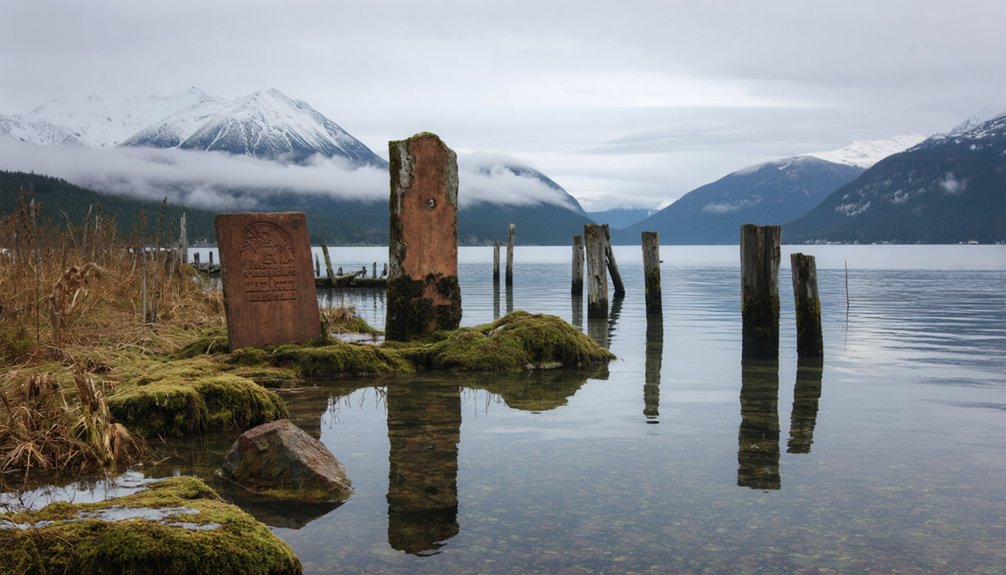
The archaeological remains at Three Saints Bay tell a complex story of cultural collision between Russian colonizers and indigenous Alutiiq people. The site’s archaeological significance lies in its preservation of both colonial structures and forced indigenous habitation areas, revealing the stark reality of Russian settlement after the tragic Awa’uq massacre of 1784.
- Excavated house pits and midden deposits expose daily life through ceramics, tools, and food remains.
- Stratigraphy reveals layers of shells, bones, and charcoal, documenting survival patterns.
- Evidence of indigenous resilience appears in continued site use long after Russian departure.
- Artifact assemblages show cultural adaptation and resistance under colonial pressure.
- Remnants of the krepost and artel camps demonstrate the settlement’s power dynamics.
You’ll find these archaeological treasures continue to uncover truths about this complex period of Alaska’s history.
Preserving a National Historic Landmark
Since receiving National Historic Landmark status in 1978, Three Saints Bay has maintained strict preservation protocols to protect its archaeological significance.
You’ll find limited physical remains at this remote site – mainly structural depressions and cultivated plants from the Russian colonial period, built atop indigenous settlements dating to 100 BCE.
The site’s preservation faces ongoing challenges from coastal erosion, climate impacts, and its isolated location.
While natural seclusion helps protect against human interference, it also complicates conservation efforts.
Federal agencies oversee site preservation through permits and legal protections, though enforcement remains difficult due to the area’s remoteness.
Despite these challenges, Three Saints Bay’s historical significance as North America’s first substantial Russian settlement continues to provide valuable insights into colonial and indigenous history through careful archaeological study and documentation.
Cultural Legacy in Modern Alaska
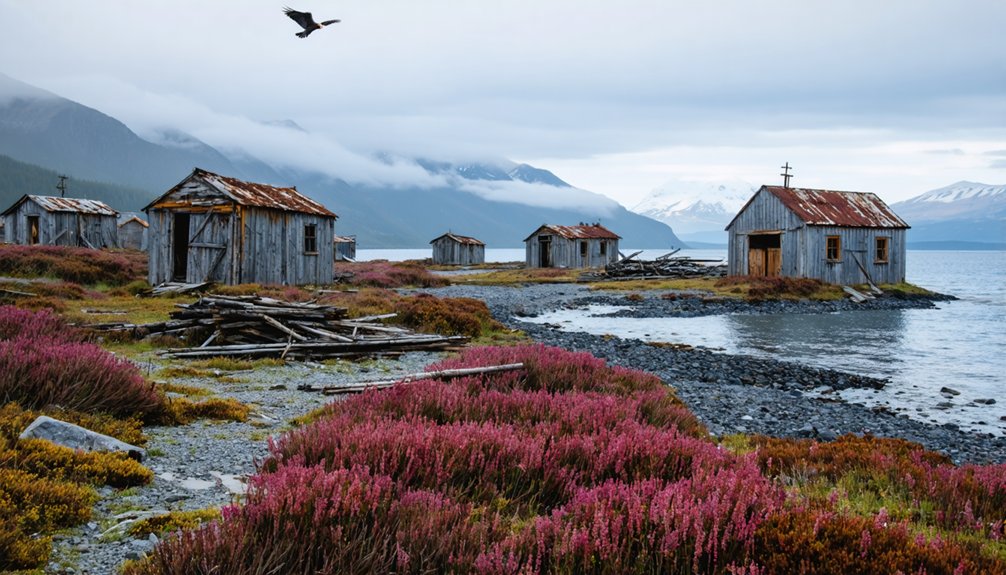
Modern Alaska’s cultural tapestry bears distinct marks of Three Saints Bay’s historical significance, where Russian and Alutiiq influences have merged into a unique heritage still visible today.
You’ll find this cultural resilience reflected in the following elements that continue to shape the region:
- Russian Orthodox religious traditions remain active, stemming from the first priests who arrived in the 1790s.
- Many Alutiiq families carry Russian surnames, a reflection of centuries of cultural interaction.
- Traditional subsistence practices blend both Russian and Alutiiq approaches to living off the land.
- Local language preservation efforts focus on maintaining Alutiiq identity while acknowledging Russian influences.
- Archaeological sites serve as living classrooms for identity preservation, where modern Alaskans can trace their mixed heritage through tangible artifacts and structures.
Frequently Asked Questions
How Cold Were Average Temperatures at Three Saints Bay During Winter Months?
Don’t let appearances fool you – winter climate at this location wasn’t brutal. Historical averages show you’d experience highs in mid-30s°F and lows around 20-30°F during December through February.
What Specific Plants and Crops Did Russian Settlers Attempt to Grow?
You’ll find that Russian settlers’ agricultural techniques focused mainly on wheat and other grain crops, but these faced severe crop failures. Evidence shows some miscellaneous garden plants, though specific varieties aren’t well documented.
How Did Settlers Communicate With Supply Ships Before Arriving at Port?
Where there’s smoke, there’s fire – you’d signal approaching supply ships using hilltop bonfires, while settler communication relied on flag signals and indigenous lookout networks for coordinating supply ship logistics.
What Traditional Medicines and Remedies Were Used at the Settlement?
You’ll find indigenous knowledge guided herbal treatments using devil’s club for colds, willow bark for pain, dandelions for vitamins, white birch for cancer, and sage for sore throats.
Did Any Settlers Marry Into Local Alutiiq Families During the Settlement Period?
Like weaving threads into fabric, you’ll find settlers did marry Alutiiq women, creating cultural integration through marriage alliances – though many unions began tragically with hostage-taking and forced relationships.
References
- https://www.thealaskalife.com/blogs/news/alaska-ghost-towns-youve-probably-never-heard-of
- https://holliskmiller.com/2018/09/17/the-three-saints-bay-artel/
- https://en.wikipedia.org/wiki/Three_Saints_Bay
- https://www.ebsco.com/research-starters/earth-and-atmospheric-sciences/three-saints-bay
- https://thealaskafrontier.com/ghost-towns-in-alaska/
- https://www.nps.gov/places/three-saints-bay-site.htm
- https://coastview.org/2024/09/21/three-saints-bay-kodiak-island/
- https://www.oldharbornativecorp.com/community/history-and-timeline/
- https://www.loc.gov/collections/meeting-of-frontiers/articles-and-essays/alaska/russian-colonization/
- https://russiaglobal.omeka.fas.harvard.edu/items/show/11
